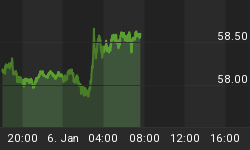Below is an excerpt from a commentary originally posted at www.speculative-investor.com on 15th September 2011.
Economists of all stripes agree that debt levels are way too high, but only a small percentage of economists understand why the total amount of debt has reached such a troublesome magnitude. Most of them come up with explanations that involve something going wrong with the financial system. For example, one group believes that the root of the problem is inadequate regulation of banks and other financial institutions. The actual cause, however, is the design of the monetary system itself. The system has achieved exactly what it was designed to achieve.
If monetary debt could only be created by lending part of the existing money supply, then the rate of growth in the economy-wide quantity of debt would be in proportion to the real growth of the economy. The fact that the total quantity of debt has expanded much faster than the real economy stems from the ability of banks to lend NEW money into existence. Fractional reserve banking is therefore the root of the debt problem.
There's actually a little more to it. After all, fractional reserve banking was around a long time before debt levels began their explosive growth. In the good old days, a fractional reserve bank would go about its business of creating money out of nothing until there was a run on the bank. If enough banks experienced a 'run' at the same time, there would be a financial crisis. Some banks would go bust, some depositors would lose their cash savings, and the economy-wide money supply would fall. In essence, there would be a system reset.
The logical way to avoid these periodic financial crises would have been to prevent banks from creating new money out of nothing, but that would have made it more difficult for banks to rapidly increase their profits and would also have severely hindered the government's ability to deficit-spend. The logical solution was therefore not implemented. Instead, high-level bankers figured out a way that banks could create money out of nothing and, in theory, never have to worry about running short of reserves. Their solution was to set up a central bank.
The "central bank" idea was sold to the public as an effective way of preventing financial crises, but after a while it became apparent that there was a fatal flaw in the idea. The flaw was the restriction on money creation imposed by the Gold Standard. How could a central bank always ensure that its member banks would never run short of reserves if the reserves were physical gold? The obvious next step, then, was to phase out the link between the official money and gold.
The final step in the design of a monetary system that would facilitate the virtually unlimited expansion of debt was to leave no doubt in the collective mind of the public that bank deposits would be 100% safe under all conditions. This was achieved via the government's provision of deposit insurance. That the government agency charged with providing the insurance never had much in the way of financial resources wasn't an issue, because a) the public was content with the government guarantee and b) if push came to shove the central bank could always create the money needed to make good on the government's guarantee.
In summary, debt levels are so high because we have a monetary system that incorporates the following features:
1. Fractional reserve banking
2. A central bank
3. No rigid link between the official money and the physical world
4. Deposit insurance
The current debt problem therefore doesn't indicate that something has gone wrong with the financial system. It is, instead, a natural and inevitable consequence of the financial system that was put in place in stages over the past century.
We aren't offering a free trial subscription at this time, but free samples of our work (excerpts from our regular commentaries) can be viewed at: http://www.speculative-investor.com/new/freesamples.html
















